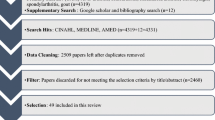Abstract
Complementary and alternative medicine (CAM) is often used by patients with multiple sclerosis (MS) but has been disregarded in research until lately. Various confounding factors on CAM utilisation exist, though have hardly been investigated. Besides socio-demographic variables like education, income, gender and age, illness-related factors like severity of disease are discussed. Furthermore, the important role of psychological factors on CAM utilisation is described. In particular, coping strategies such as “rumination”, “search for information” and “search for meaning in religion” are more often reported by CAM users than non-users and have important impact on CAM utilisation.
Similar content being viewed by others
References
Apel A, Greim B, König N, Zettl UK(2004) The role of coping and depressionin utilisation of complementaryand alternative medicine by multiplesclerosis patients. Mult Scler 10:S138–S139
Apel A, Greim B, König N, Zettl UK(2006) Frequency of current utilisationof complementary and alternativemedicine by patients with multiplesclerosis. J Neurol 253:1331–1336
Apel A, Greim B, Zettl UK (2004)Utilisation of complementary andalternative medicine by multiplesclerosis patients. Mult Scler 10:S114–S115
Apel A, Greim B, Zettl UK (2007) Complementaryand alternative medicineand coping in neuroimmunologicaldiseases. J Neurol 254:II112–II115
Astin JA (1998) Why patients use alternativemedicine. JAMA 279:1548–1553
Bensoussan A (1999) Complementarymedicine – where lies its appeal? Med JAust 170:247–248
Berkman CS, Pignotti MG, Cavallo PF,Holland NJ (1999) Use of alternativetreatments by people with multiplesclerosis. Neurorehabil Neural Repair13:243–254
Caspi O, Sechrest L, Pitluk HC,Marshall CL, Bell IR, Nichter M (2003)On the definition of complementary,alternative, and integrative medicine:societal mega-stereotypes vs. the patients’perspectives. Altern Ther HealthMed 9:58–62
Eisenberg DM, Davis RB, Ettner SL,Appel S, Wilkey S, Van Rompay M, et al.(1998) Trends in alternative medicineuse in the United States, 1990–1997:results of a follow-up national survey.JAMA 280:1569–1575
Ernst E, Casseleth BR (1998) Theprevalence of complementary/alternativemedicine in cancer: a systematicreview. Cancer 83:777–782
Feinstein A (1997) Multiple sclerosis,depression and suicide. BMJ 315:691–692
Furnham A, Kirkcaldy B (1996) Thehealth beliefs and behaviours of orthodoxand complementary medicineclients. Br J Clin Psychol 35:49–61
Kranz R, Rosenmund A (1998) Themotivation to use complementarymedicine healing methods. Study of ageneral internal medicine and orthopedicpatient sample. Schweiz MedWochenschr 128:616–622
Launso L (2000) Use of alternativetreatments in Denmark: patterns ofuse and patients’ experience withtreatment effects. Altern Ther HealthMed 6:102–107
Launso L, Haahr N (2007) Bridgebuilding and integrative treatment ofpeople with multiple sclerosis. Research-based evaluation of a team-buildingprocess. J Complement IntegrMed 4:article 7
MacLennan AH, Wilson DH, Taylor AW(1996) Prevalence and cost of alternativemedicine in Australia. Lancet 347:569–573
Marrie RA, Hadjimichael O, Vollmer T(2003) Predictors of alternative medicineuse by multiple sclerosis patients.Mult Scler 9:461–466
Melchart D, Mitscherlich F, Amiet M,Eichenberger R, Koch P (2005) ProgrammEvaluation Komplementärmedizin(PEK) Schlussbericht SwissFederal Office of Public Health
Moschen R, Kemmler G, SchweigkoflerH, Holzner B, Dunser M, Richter R,et al. (2001) Use of alternative/complementarytherapy in breast cancerpatients – a psychological perspective.Support Care Cancer 9:267–274
National Center of Complementaryand Alternative Medicine (NCCAM)(2008) What is complementary andalternative medicine (CAM)? http://nccam.nih.gov/health/whatiscam/Accessed: July 25, 2008
Nayak S, Matheis RJ, Schoenberger NE,Shiflett SC (2003) Use of unconventionaltherapies by individuals withmultiple sclerosis. Clin Rehabil 17:181–191
Rajendran PR, Thompson RE, ReichSG (2001) The use of alternative therapiesby patients with Parkinson’s disease.Neurology 57:790–794
Sadovnik AD, Remick RA, Allen J,Swartz E, Yee IML, Eisen K (1996)Depression and multiple sclerosis.Neurology 46:628–632
Schubert DS, Foliart RH (1993) Increaseddepression in multiple sclerosispatients. A meta-analysis. Psychosomatics34:124–130
Schwartz CE, Laitin E, Brotman S,LaRocca N (1999) Utilization of unconventionaltreatments by personswith MS: is it alternative or complementary?Neurology 52:626–629
Sirois FM, Gick ML (2002) An investigationof health beliefs and motivationsof complementary medicineclients. Soc Sci Med 55:1025–1037
Sirven JI, Drazkowski JF, ZimmermanRS, Bortz JJ, Shulman DL, Macleish M(2003) Complementary/alternativemedicine for epilepsy in Arizona.Neurology 61:576–577
Stenager E, Stenager EN, Knudsen L,Jensen K (1995) The use of non-medical/alternative treatment in multiplesclerosis. A 5 year follow-up study. ActaNeurol Belg 95:18–22
Stenager EN, Stenager E, Koch-HenriksenN, Bronnum-Hansen H, HyllestedK, Jensen K, et al. (1992) Suicide andmultiple sclerosis: an epidemiologicalinvestigation. J Neurol Neurosurg Psychiatry55:542–545
Vincent C, Furnham A (1996) Why dopatients turn to complementary medicine?An empirical study. Br J Clin Psychol35:37–48
Vincent C, Furnham A (1997) Complementarymedicine: a research perspective.Wiley, Chichester
Wang Y, Hashimoto S, Ramsum D,Findlay B, Best A, Oger J (1999) A pilotstudy of the use of alternative medicinein multiple sclerosis patients withspecial focus on acupuncture. Neurology52:A550
Wapf V, Busato A (2007) Patients’motives for choosing a physician:comparison between conventional andcomplementary medicine in Swissprimary care. BMC ComplementAltern Med 7:41
Zollman C, Vickers A (1999) ABC ofcomplementary medicine. Complementarymedicine in conventionalpractice. BMJ 319:901–904
Author information
Authors and Affiliations
Corresponding author
Additional information
Conflict of interest The authors have no conflict of interest to declare.
Rights and permissions
About this article
Cite this article
Apel-Neu, A., Zettl, U.K. Complementary and alternative medicine in multiple sclerosis. J Neurol 255 (Suppl 6), 82–86 (2008). https://doi.org/10.1007/s00415-008-6015-9
Issue Date:
DOI: https://doi.org/10.1007/s00415-008-6015-9




